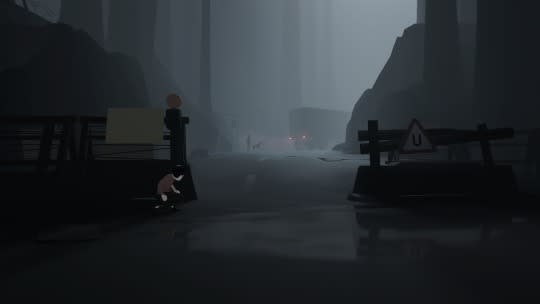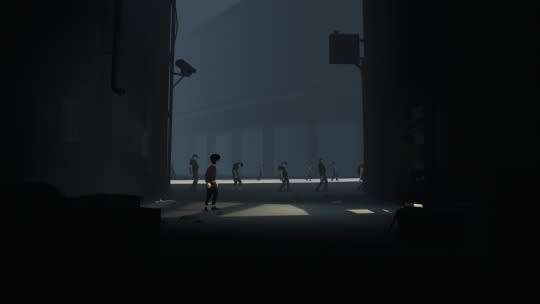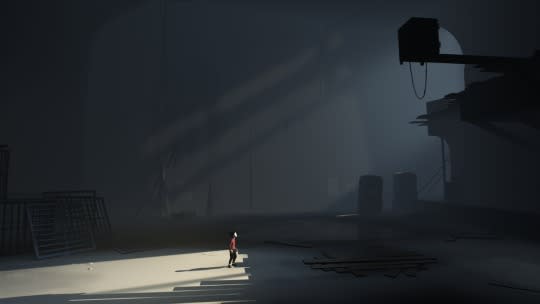Review: Nightmarish ‘Inside’ is an instant classic

You’re a young boy. You’re running through the woods at night. In the distance, intimidating men wave flashlights. Dogs sniff the air, barking and gnashing their teeth. You’d pause to catch your breath and consider your options, but there’s really only one: run, and keep running.
This is how Inside (Xbox One, $20), the latest 2D platformer by indie developer Playdead, begins. And in large part, it’s how it continues. Like the company’s first effort, the acclaimed Limbo, Inside is not about complex mechanics or wildly innovative systems. It is about a boy lost in the woods, ostensibly, though having completed the game twice now, I’m sure it’s about much, much more. I’m just not entirely sure what that is.
I am, however, certain that Inside is one of the year’s best games. Simultaneously uplifting and upsetting, it’s a gorgeous, enigmatic master class in pacing, design, and visual storytelling.
At first, however, Inside feels like Limbo’s weirdo cousin. Off to the right you run, side-scrolling your way through a dark, foreboding world. The initial rural vibe quickly gives way to urban factories and decrepit buildings, each scene curiously tacked on to the last in a way that makes sense, spatially speaking — but only just. Playdead masterfully ratchets up the tension with a dreamlike design that is at once foreign and familiar. That’s what a building looks like, sure, but the architecture just seems off.

It doesn’t take long for Inside to show its creepy roots. Who are you? Where are you? Heck, when are you? Why are you being chased? What the hell happened here? Inside doesn’t spell out any answers. There are no signposts, no text descriptors, no cut scenes or voicework, or really any explanations. Inside is an impression of things gone wrong, a nightmare in the truest sense, and while you will eventually piece together a narrative, that’s not really the point.
The point, if there is one, is to make you feel a little uneasy — like, all the time. It isn’t scary so much as discomforting. A sense of despair and inevitability runs through Inside, a persistent, low-level hum of dread (and, occasionally, a weird, wormy thing) urging you to keep moving and exploring.
Most of the time that means navigating physics-based puzzles — moving boxes, swinging from ropes, manipulating levers — but it doesn’t feel like busywork. Playdead weaves puzzles seamlessly into environments; you never really question where to go or how to get there, and rarely does a puzzle feel tossed in simply for the sake of giving the player something to do. And it’s all handled exceptionally well, thanks to beautiful animations and crisp controls.
That said, Inside does occasionally stumble, particularly in a second act filled with a few too many fiddly, lever-pulling bits that stand in contrast to the more organic puzzles found throughout the rest of the game. The good news? Unlike Limbo, Inside isn’t trying to kill you every five minutes. You will die, that’s for sure, but this isn’t a punishing ordeal of jump scares and near-misses. A few intricate puzzles aside, Inside deftly avoids cheap, constant death and forced repetition.

On the contrary, Inside is bursting with wonderfully inventive moments that utilize its simple, two-button controls in fascinating ways that rarely outstay their welcome. Naturally, it’s difficult to speak at length about any of that without ruining the thrill of discovery; suffice to say you don’t just run and jump and push boxes the whole time.
Driving it all home is the breathtaking aesthetic. Limbo’s stark black-and-white visual treatment was tonally perfect. Inside channels that philosophy, but amps up the detail to impossibly cool levels. It doesn’t pop with color — it’s dark and gray, mostly — yet is bursting with life, from the boy’s seemingly endless array of incidental animations to the dozens of background vignettes that both flesh out the world and inform/impede your progress. Inside does magical things with the intersection of the playable foreground and the (seemingly) noninteractive background. Never has a flat, 2D world been given this much depth.
One of the biggest criticisms of Limbo was its brief running time, and I’m guessing a subset of gamers will similarly take Inside to task for this. I’m not a fan of determining video game value by tallying the amount of hours poured into it, but if that’s your jam, then yes, Inside is short and you will possibly be grumpy about paying $20 for it. But by its glorious end, I wasn’t so much itching for another level as I was staring at the screen, dumbfounded, and anxious to restart and relive it all again.
That’s partly due to an unthinkably awesome turn in the game’s final act — seriously one of the greatest wtf is happening twists in gaming history — but even without it, Inside is an artistic triumph. Video games, at their best, fold their various components into a whole that is far greater than the sum of their parts. Inside does exactly that, and more so does exactly what its name implies: it gets in your head, in your system, and stays there.

What’s hot: Unique, beautiful, haunting; brilliant design and control; atmosphere for days; tells a creepy, captivating tale without uttering a word
What’s not: Core gameplay might not prove enough of a challenge; runs a little short
Platform reviewed: Xbox One
Ben Silverman loved Limbo, too. He’s on Twitter @ben_silverman.

